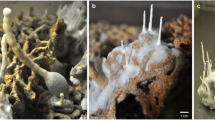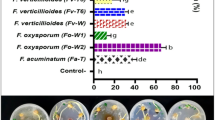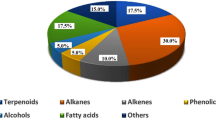Abstract
A new eremophilane sesquiterpene, 13,13-dimethoxyintegric acid (1), together with known compound integric acid (2) have been isolated from a fungus, Xylaria sp. V-27, obtained from a dead branch. The structure of 1 was established by means of spectroscopic analyses. 1 and 2 promoted growth restoring activity against the mutant yeast strain (Saccharomyces cerevisiae (zds1Δ erg3Δ pdr1Δ pdr3Δ)) and inhibited degranulation of rat basophilic leukemia RBL-2H3 cells stimulated by immnunoglobulin G + 2,4-dinitrophenylated-bovine serum albumin (IgE+DNP-BSA), thapsigargin and A23187.
Similar content being viewed by others
Log in or create a free account to read this content
Gain free access to this article, as well as selected content from this journal and more on nature.com
or
References
McDonald, L. A. et al. 07H239-A, a new cytotoxic eremophilane sesquiterpene from the marine- derived Xylariaceous fungus LL-07H239. J. Nat. Prod. 67, 1565–1567 (2004).
Isaka, M., Chinthanom, P., Boonruangprapa, T., Rungjindamai, N. & Pinruan, U. Eremophilane-type sesquiterpenes from the fungus Xylaria sp. BCC 21097. J. Nat. Prod. 73, 683–687 (2010).
Singh, S. B. et al. Structure and absolute stereochemistry of HIV-1 integrase inhibitor integric acid. A novel eremophilane sesquiterpenoid produced by a Xylaria sp. Tetrahedron Lett. 40, 8775–8779 (1999).
Smith, C. J. et al. Novel sesquiterpenoids from the fermentation of Xylaria persicaria are selective ligands for the NPY Y5 receptor. J. Org. Chem. 67, 5001–5004 (2002).
Song, Y. et al. Four eremophilane sesquiterpenes from the mangrove endophytic fungus Xylaria sp. BL321. Mar. Drugs 10, 340–348 (2012).
Isaka, M., Yangchum, A., Supothina, S., Chanthaket, R. & Srikitikulchai, P. Isopimaranes and eremophilanes from the wood-decay fungus Xylaria allantoidea BCC 23163. Phytochem. Lett. 8, 59–64 (2014).
Shiono, Y. & Murayama, T. New eremophilane-type sesquiterpenoids, eremoxylarins A and B from Xylariaceous endophytic fungus YUA-026. Z. Naturforsch. 60b, 885–890 (2005).
Ogasawara, Y., Yoshida, J., Shiono, Y., Miyakawa, T. & Kimura, K. New eremophilane sesquiterpenoid compounds, eremoxylarins A and B directly inhibit calcineurin in a manner independent of immunophilin. J. Antibiot. 61, 496–502 (2008).
Abe, T. et al. Yeast Ca2+-signal transduction inhibitors isolated from Dominican amber prevent the degranulation of RBL-2H3 cells through the inhibition of Ca2+-influx. Fitoterapia 113, 188–194 (2016).
Acknowledgements
AT acknowledges the JSPS RONPAKU (dissertation PhD, ID: R11516) Program for financial support.
Author information
Authors and Affiliations
Corresponding author
Ethics declarations
Competing interests
The authors declare no conflict of interest.
Additional information
Supplementary Information accompanies the paper on The Journal of Antibiotics website
Supplementary information
Rights and permissions
About this article
Cite this article
Tchoukoua, A., Suzuki, T., Ariefta, N. et al. A new eremophilane sesquiterpene from the fungus Xylaria sp. V-27 and inhibition activity against degranulation in RBL-2H3 cells. J Antibiot 70, 1129–1132 (2017). https://doi.org/10.1038/ja.2017.120
Received:
Revised:
Accepted:
Published:
Issue date:
DOI: https://doi.org/10.1038/ja.2017.120



